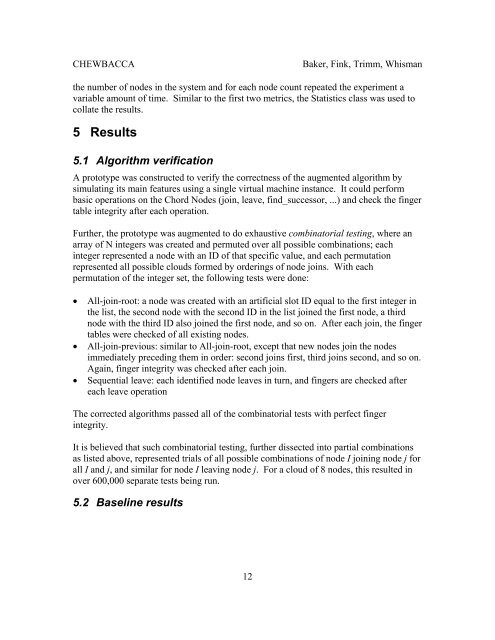Implementing a Distributed Peer to Peer File Sharing System ... - Umbc
Implementing a Distributed Peer to Peer File Sharing System ... - Umbc
Implementing a Distributed Peer to Peer File Sharing System ... - Umbc
Create successful ePaper yourself
Turn your PDF publications into a flip-book with our unique Google optimized e-Paper software.
CHEWBACCA Baker, Fink, Trimm, Whisman<br />
the number of nodes in the system and for each node count repeated the experiment a<br />
variable amount of time. Similar <strong>to</strong> the first two metrics, the Statistics class was used <strong>to</strong><br />
collate the results.<br />
5 Results<br />
5.1 Algorithm verification<br />
A pro<strong>to</strong>type was constructed <strong>to</strong> verify the correctness of the augmented algorithm by<br />
simulating its main features using a single virtual machine instance. It could perform<br />
basic operations on the Chord Nodes (join, leave, find_successor, ...) and check the finger<br />
table integrity after each operation.<br />
Further, the pro<strong>to</strong>type was augmented <strong>to</strong> do exhaustive combina<strong>to</strong>rial testing, where an<br />
array of N integers was created and permuted over all possible combinations; each<br />
integer represented a node with an ID of that specific value, and each permutation<br />
represented all possible clouds formed by orderings of node joins. With each<br />
permutation of the integer set, the following tests were done:<br />
• All-join-root: a node was created with an artificial slot ID equal <strong>to</strong> the first integer in<br />
the list, the second node with the second ID in the list joined the first node, a third<br />
node with the third ID also joined the first node, and so on. After each join, the finger<br />
tables were checked of all existing nodes.<br />
• All-join-previous: similar <strong>to</strong> All-join-root, except that new nodes join the nodes<br />
immediately preceding them in order: second joins first, third joins second, and so on.<br />
Again, finger integrity was checked after each join.<br />
• Sequential leave: each identified node leaves in turn, and fingers are checked after<br />
each leave operation<br />
The corrected algorithms passed all of the combina<strong>to</strong>rial tests with perfect finger<br />
integrity.<br />
It is believed that such combina<strong>to</strong>rial testing, further dissected in<strong>to</strong> partial combinations<br />
as listed above, represented trials of all possible combinations of node I joining node j for<br />
all I and j, and similar for node I leaving node j. For a cloud of 8 nodes, this resulted in<br />
over 600,000 separate tests being run.<br />
5.2 Baseline results<br />
12











